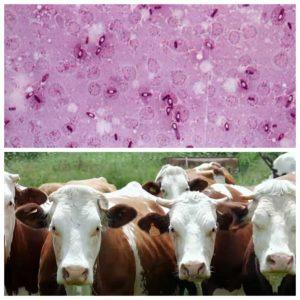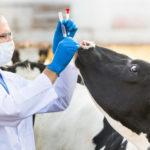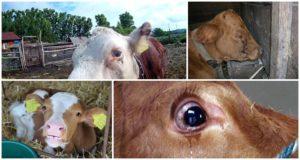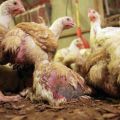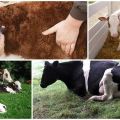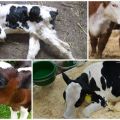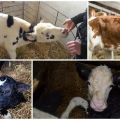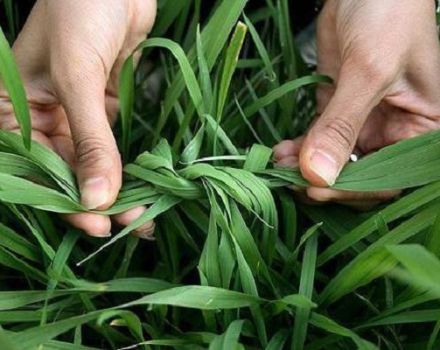Causes and symptoms of coccidiosis in cattle, treatment and prevention
Coccidioses are a group of infectious diseases of animals and birds that cause protozoa - coccidia. They parasitize on the intestinal mucosa, which leads to the development of a severe, often fatal disease. Young animals die especially a lot. Consider the causes of cattle coccidiosis, symptoms of the disease, methods of diagnosis, therapy and prevention.
Causes of the disease
Coccidiosis in cows is the most common intestinal disease in young animals. 3-12-week-old calves are sick, less often older individuals. Adults are usually carriers of coccidia, they rarely get sick. The disease can be caused by up to 10 species of protozoa.
Coccidiosis occurs everywhere, mainly in farms with unsatisfactory housing or feeding conditions. Coccidiosis is most common during rainy seasons and where wet pastures are used for grazing. Stress after changing feed, veterinary procedures and transportation can also trigger the development of coccidiosis.
Infection with protozoa occurs through food, drinking water, care items and feeders that are infected with protozoan oocysts.
Cattle become infected with coccidiosis by ingesting oocysts with food or water. Protozoa enter the intestines, settle on the epithelium of the mucous membrane. The cells peel off, the mucous membrane becomes inflamed, the villi grow, deform and collapse. Destruction of small vessels occurs, the intestinal walls swell, parietal digestion is disturbed, nutrients are poorly absorbed. In places affected by coccidia, pathogens multiply intensively, further increasing intestinal inflammation. Diarrhea is the result.

With a mild form of coccidiosis, recovery may occur in 3-4 days from the onset of the disease. The disease in a protracted form can last for several months. Death in this case occurs from anemia. Even after recovery, individuals who have recovered remain carriers of coccidia.
Symptoms of the disease
The incubation period for coccidiosis lasts 2-3 weeks. The initial signs are indigestion. The calves' feces become thin and fetid, streaked with blood, in severe cases bloody diarrhea and fever are noted. Animals are depressed, appetite is greatly weakened, with severe course it is absent, chewing gum stops. They can hardly walk, the gait is shaky, unsure. Calf death can occur 5-21 days. With a large number of infected young animals, the mortality rate can be high.
Sick calves reduce feed intake, growth retardation and dehydration occur. Animals are emaciated, the mucous membranes of the mouth and eyes turn pale. The anus and tail are stained with feces, the lymph nodes of the mesentery are enlarged. If milking cows are sick, milk yield decreases.
In dead animals, the contents of the intestines are dirty brown, the mucous membrane of the large intestines is hyperemic, with numerous hemorrhages, specific whitish coccidial accumulations are clearly visible on it. There is an increase in the heart, liver and kidney dystrophy, hyperemia and pulmonary edema.
Diagnosis of pathology
In addition to clinical signs, tests are needed to diagnose the disease. For this, the feces of sick cows are taken, the disease is confirmed if coccidial oocysts are found in it. Re-taking tests is also carried out, if it is necessary to clarify the diagnosis.
Coccidiosis is differentiated from colibacillosis, clostridiosis, salmonellosis.
Treatment and prevention of coccidiosis
Treatment of the disease is aimed at eliminating coccidia and stopping their reproduction. Therapy is carried out with the use of special anti-coccidial drugs. During therapy, sick calves are isolated from a healthy herd. The stables where they were located are disinfected with hot liquor. Anti-coccidiosis drugs are mixed with milk and the solution is fed to the calves. For young animals, a solution is prepared by mixing medicines, for example, "Baycox" with water.
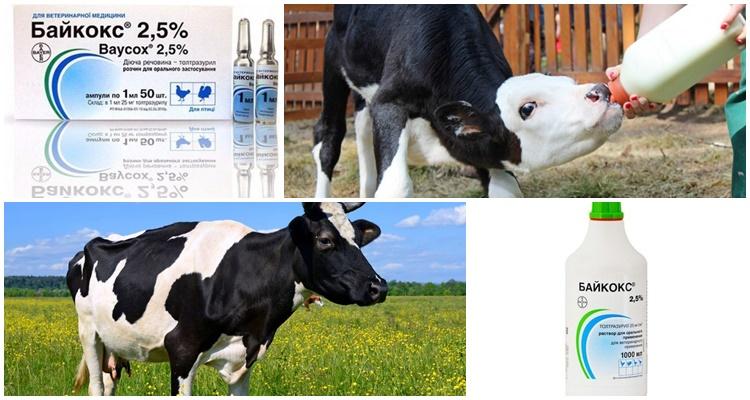
The litter is changed every day so that there are no traces of manure. Feeders, drinkers and equipment are scalded with boiling water. Exposure to high temperatures is necessary, since almost all disinfectants are powerless against coccidia due to their dense shell. Fresh sand is sprinkled on the walking area to minimize contact of healthy animals with manure left by sick individuals. Calves are grazed on separate pastures. They feed dry food, give clean water.
Harmfulness
Coccidiosis, like other dangerous cattle infections, causes economic damage to farms. Loss of income occurs due to a slowdown in the growth of young animals or their death, the incidence of other infectious diseases in calves against the background of coccidiosis, due to the cost of complex treatment.
Preventive actions
Sick calves are kept apart from healthy calves during treatment. You need to clean the manure every day and change the litter. Every week you need to douse the floors with boiling water and a solution of caustic soda. Buckets and feeders also need to be disinfected with boiling water (coccidia die from high temperatures). Cover the yard where animals walk with clean sand. Graze calves and young animals in areas where there are no damp, wetlands, where sick individuals did not graze. If possible, change pastures every week.
Coccidiosis poses a danger to calves up to six months of age. Mostly those animals that live in insufficient sanitary conditions, with weakened immunity, are infected. Few recover without treatment; a significant proportion of sick animals die. The treatment started on time gives the animals a chance to recover.
